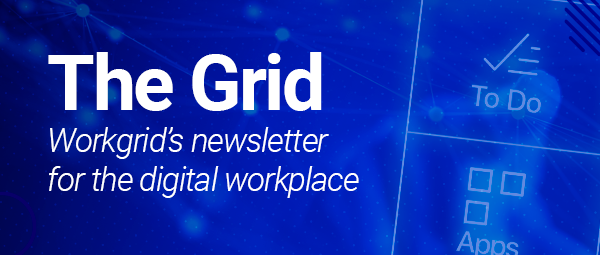Last week, I had the pleasure of joining Igloo Software’s Breakfast Club, an in-person networking and panel-session event focused on digital workplace lessons learned and strategies for 2023.
It’s no doubt that a digital workplace is valuable and drives utility to employees across organizations of any size. But hearing insights straight from someone who has dedicated their time into making a digital workplace successful is always enlightening given the source.
During the session, the panelist chatted about digital workplace challenges, digital workplace ownership, and the ever-evolving role for the digital workplace manager - plus lots of helpful insights and tips for building engaging digital workplaces.
The three-panelist featured at the session included:
Stefanie Barton, Internal Communications Manager, Ford Foundation
Cristina Herrera, Sr. Internal Communications Specialist, Teachers Federal Credit Union
Richard Gambale, Senior Director of Marketing Strategy, Jewish Board of Family and Children's Services
Digital Workplace Need Has Grown Post-Pandemic
While each digital workplace is different, they all tend to face similar challenges and opportunities. In context of today’s discussion, we will refer to a digital workplace as your main digital workplace hub, what previously may have been labeled as your company intranet.
We know that intranets have evolved to digital destinations for employees and are more important than ever today with the lack of physical offices for many.
The digital workplace of today serves as the bridge connecting people and information from across locations. As one panelist shared, their digital workplace is now the map and compass for the work they do.
![[asset] compass-stock-photo](https://images.ctfassets.net/z7p73u8c0thn/3uyOmX66luYqZoJrThtUtj/1441c2484e2d91f68329ea996c9bd5f3/compass-stock-photo.png?w=1200&h=675&q=60&fm=png&bg=transparent)
Let’s dive in by looking at the main drivers each organization had for launching a new digital workplace platform.
The need for connection
Whether organizations opt for a fully remote or hybrid work model, the physical workplace has been deprioritized as the cornerstone of the work experience.
The digital workplace now holds the responsibility of bringing people and work together. One panelist shared just how critical their digital workplace became during the pandemic. It was a change they said they literally saw happen overnight.
Their digital workplace was already an effective tool for employees, with a highly engaged newsroom but during the pandemic it took on a new form, a support mechanism for employees to connect with one and another, something they could have never predicted the digital workplace would support.
At a time where everyone was a bit uneasy, employees utilized the digital workplace to share updates and organically people started to connect with each other and formed a sense of community during a time that was difficult and challenging for many.
Formal ownership & broader reach across the organization
Often digital workplaces start off as a solution managed by IT-departments, creating bottlenecks across the organization when only IT can make updates and improvements to the platform.
Or perhaps there is no ownership of your digital workplace, and you don’t have an official digital workplace but rather a disparate set of tools all individually managed by different departments.
This results in a cluttered experience with a series of individual tools that don’t work well together, a challenge many organizations face because technology decisions were made in silos based on each department’s unique objectives.
Today’s successful digital workplaces require formal ownership.
Your digital workplace is a living breathing thing. It needs constant care, attention, and love. Similar to a two year old, you can't take your eyes off of it.
By having formal ownership, you can give the digital workplace the attention it needs to thrive across your organization and be a useful tool for employees each day. Establishing formal ownership ensures that a shared vision of the employee experience is incorporated across the organization and your digital workplace or intranet is part of that vision.
With specialty roles owning the digital workplace (i.e., digital workplace leader), the Digital Workplace Manager can look beyond the tool itself and strategize how to evolve the digital workplace from being essential to mission critical.
![[asset] Digital Workplace Organizational Model](https://images.ctfassets.net/z7p73u8c0thn/4SFdnE3wSXwbvM72aJrAsG/0bd4b5de34674f52f14bd94c7e6e499f/Ownership_graphic.jpg?w=1200&h=607&fl=progressive&q=60&fm=jpg&bg=transparent)
Where should digital workplace ownership sit within a company?
Where the ownership of the digital workplace sits within a company is going to be different depending on the size and structure of your organization. Whatever department it may sit in should have senior leadership support and a strong understanding of the value the digital workplace drives.
Formal ownership can be within its own department, such as a digital workplace team or fall within another team such as Internal Communications or Marketing. Either way, it should be given independent ownership to ensure that the digital workplace has its own priorities, strategic vision, and roadmap, ensuring it isn’t a conflicting priority against other objectives.
Furthermore, having holistic reach across the organization to bring together the right stakeholders such as IT, HR, Facilities Management, and so on will be important to ensure that the digital workplace encompasses what’s important across the entire organization.
Siloed information with knowledge spread out across too many places
All three panelists highlighted how information and data was greatly siloed and spread out across too many places prior to the launch of their new digital workplace.
Often, information would sit within a system that was not searchable, making it frustrating for employees to find what they needed.
Furthermore, without a centralized location to store repositories of information, critical data sat in the hands of employees' desktop or local drives without any process for knowledge sharing or transfer. If that employee left the organization, all that information was also gone.
Shadow IT
One panelist shared an example of how their previous digital workplace platform was not sufficient for employees, creating unnecessary opportunities to shadow IT.
Shadow IT, the use of technology systems, devices, software, applications, and services without explicit IT department approval is an issue that has grown in recent years with the adoption of cloud-based applications and services.
Their previous digital workplace was only accessible on internal networks (i.e., in the office), yet their organization had employees whose jobs required them to work in a variety of locations.
These employees could not get access to the information they needed while on the road, so as you’d expect they created their own solution to the problem. They created Google sites to store and leverage information while on the road.
Although this work was done with good intentions it put the company at risk, and furthermore with nobody to own and maintain that content, most of the material stored on the Google site quickly became outdated.
By simply giving employees the tools they need in a modern, accessible location you can help mitigate the risk of shadow IT
Challenges for Digital Workplace Owners
So, what are some of the challenges of owning and maintaining a digital workplace platform. The panelists shared some of their own challenges and tips for strategies in 2023.
Keeping up the integrity of the digital workplace
Maintenance is extremely important to digital workplaces, ensuring that the content and resources are fresh and up to date.
As knowledge and information grows on the digital workplace, having an easy-to-understand structure in place for employees to find information is helpful to ensure employees can find what they need and also trust the information they find is the right information. For some companies, keeping information accurate is business critical as it relates to compliance and regulatory data.
One panelist shared that they conducted regular surveys, asking employees specifically what things on the digital workplace were hard to find or were missing that they wish were on the intranet.
This allowed the Digital Workplace Manager to make small incremental changes often, improving the value and usability of the digital workplace.
Another panelist shared insights related to having an audit process that involved assigning content managers and picking a cadence for them to update their respective digital workplace pages and repositories.
With advancements of artificial intelligence and technologies like Workgrid, advances are coming to make the lives of knowledge managers easier.
For example, this year Workgrid released a new app that helps notify content authors of potentially stale content that could need updating.
Workgrid's Stale Content App integrates with Igloo-based digital workplaces to help improve knowledge management by:
Sending notifications suggesting authors update or archive content that hasn't been engaged with after 180 days
Compares article authors against active users in Igloo, alerting content managers if an author is an inactive users and the posts may need archiving or updating
![[asset] Igloo Content Notification](https://images.ctfassets.net/z7p73u8c0thn/7etF3Nj3YBvOm2tSuTpdPa/2f6ab7425704ea05129e6440b23283c7/Template-Hero-Igloo-Stale-Content.png?w=1200&h=1200&q=60&fm=png&bg=transparent)
Promoting content at the right frequency and balance
Having the right frequency of content on the digital workplace is an important balance that the panelists shared. Expressing that each company’s needs will be unique, but for digital workplace owners to beware not to fall into the trap of trying to promote content at a cadence that is too much for employees to digest.
Most employees genuinely want to engage with content on the digital workplace and learn what’s new at the company. However, if there are too many postings, employees could feel overwhelmed and not feel they are able to keep up with the content.
A panelist shared they saw greater engagement with posts when they limited the number of posts. For example, instead of posting 3-4 times a day for instance, focus on 3-4 times a week, this way employees have the time to fully engage in each article if they only have a few minutes a day or a chunk of time a week.
Change management was also discussed to ensure that leaders and managers empowered employees to feel comfortable with spending time commenting and engaging with content on the digital workplace.
How to Continuously Add Value to your Digital Workplace
Understanding your employees
One panelist shared a successful user study she conducted to understand how employees used the digital workplace. She gathered 15 or so employees that ranged across job function and tenure and created a list of actions for the employee to conduct using the digital workplace.
As the employee conducted each task, their screen was monitored so the user study could showcase how an employee would go about finding and searching for information (what buttons they clicked, what they typed into the search panel, the path they took, etc.)
Seeing firsthand from a user study can give you incredible insight into how your content is structured and how user friendly the UX is of your intranet. People think differently, ask questions differently, and so on.
The work this company did is a perfect example of how to go about conducting user studies to understand how your digital workplace is functioning and what matters to employees, allowing you to create experiences on your digital workplace that solve the common pain points that matter most to employees.
![[asset] Sample User Journey](https://images.ctfassets.net/z7p73u8c0thn/2yTkfCios4yXfHD79g48xR/0e0462aa96bba93164df6ca230b73f1c/Sample_User_Journey.png?w=800&h=569&q=60&fm=png&bg=transparent)
Journey mapping is a tool used to identify opportunities for improving the employee experience by visually outlining the end-to-end experience an employee has throughout their time with an organization.
To learn more about how to create employee personas and conduct user studies, view our employee journey mapping guide.
Good search is important
Having good search on the digital workplace is important. Employees will quickly lose trust in your digital workplace if they can’t find the answers they need or are presented with irrelevant information that is outdated or forced to sift through dozens of pieces of content that is not relevant to their question.
At the end of the day, improved knowledge leads to better decision making which is a clear driver for better business outcomes.
With all the advancements in artificial intelligence, search is getting smarter. Think about how Google search has evolved over the years.
Years ago, if you searched for “Mexican restaurant” Google would likely give you the definition of a Mexican restaurant. Now, Google uses context to make suggestions based on your search.
Rather than surfacing the definition of a Mexican restaurant, you would receive search results with Mexican restaurants near you, because it knows your location. Furthermore, it’s likely the search will also surface actionable items related to Mexican restaurants such as booking a table or popular reviews of that restaurant, without the need for you to even click through to these websites.
![[asset] google-search-mexican-restaurant](https://images.ctfassets.net/z7p73u8c0thn/1WxVfzhw8x0q3couS5GsLS/6c9e7cafca19349bd57d31bd469e3787/google-search-mexican.png?w=992&h=575&q=60&fm=png&bg=transparent)
This is how technology for digital workplaces will also evolve and much of this technology is closer to being available than you may think.
Deploying a chatbot for your digital workplace is a great way to make searching for information and documents easier to find.
You can leverage artificial intelligence and machine learning capabilities to help train the chatbot to deliver answers to specific questions, personalizing responses to different employee personas across your organization and leveraging data attributes you already know (location, job function, etc.).
This way when an employee asks a specific question, like when is the next holiday, rather than sending the employee to a 30-page PDF with details across 30 offices, the response could be as simple as: The next company holiday is Memorial Day. To view all holidays, visit the company holiday list.
![[asset] chatbot-card-update](https://images.ctfassets.net/z7p73u8c0thn/4Ji97Vj7WCxEOPJPeEn0y7/d761c6bdc2d52c568880d647da1b78b8/chatbot-card-update__1_.png?w=1200&h=800&q=60&fm=png&bg=transparent)
Measuring the Success of your Digital Workplace
Monitoring the performance and value the digital workplace delivers to employees is critical to its overall success.
To understand the value your digital workplace is driving you need to measure a broad set of data points. Also, after listening to the panelists it was clear that some of the value doesn’t come in readily available metrics, especially those related to driving employee engagement and culture.
A few metrics that were discussed included but not limited to:
Productivity
The three panelists all agreed that one of the most important metrics they measured was around productivity. What were the call to actions influencing employees to take action.
Leveraging the digital workplace for effectively communicating open enrollment was an example share across all three panelists. Open enrollment is a time sensitive process that frequently can be easily missed by employees if the communications for open enrollment are trapped in email.
By using your digital workplace to build out a campaign consisting of communications, content, and helpful resources for employees, all three panelists shared similar success stories of using their digital workplaces to help with open enrollment. Employees taking action from the digital workplace during the open enrollment period was a trackable metric for the panelists to determine success.
Overall, the sentiment was that a key to driving productivity on the digital workplace was making it easier for employees to find the resources they need and complete actions – from updating their insurance, taking an employee engagement survey, signing up the annual volunteering event, getting the payroll update, and so on.
Creating a single, intuitive experience to surface information, alerts, and tasks not only gives your employees instant access to what needs their attention but helps employees spend more time on the things that drive your organization forward.
Using your digital workplace as a catalyst to allow employees to easily complete tasks and find information can be directly tied back to making a business case for your digital workplace because it shows how the platform reduces business cost, saves time, and improves efficiency.
Digital workplaces are becoming more and more integrated. A modern digital workplace platform, like Igloo Software, enables employees to have information from third-party systems integrated directly on the intranet, eliminating the need for employees to jump from system to system.
![[Gif] Intranet-Workgrid-Toolbar](http://images.ctfassets.net/z7p73u8c0thn/3ixSBimPmyrkWmtYNDSZsF/8765a7cc9050036dc1419031055dc31e/Intranet_Animation_WG_Walkthrough_.gif)
Workgrid makes it easy to add integrations to an existing intranet through the use of our intranet digital assistant, this is a great option for customers looking to modernize their intranet without the hassle of replacing existing systems or paying for pricey statements of work for custom-built integrations.
Connecting Employees and Driving Culture
The panelists each told some incredible stories of how much their digital workplaces drove connectivity and helped build culture. The level of engagement expressed in their stories is something that is not easily measured from a digital tool. Even surveys may make it hard to fully encompass the sentiment that the panelists shared.
Each panelist used different business indicators of culture in action to help measure culture, but all three shared stories of just how pleasantly surprised they were to see how much employees engaged with the digital workplace from a social aspect, bringing together employees in ways they may not have planned for.
Overall, it’s clear that creating a modern digital workplace that supports long-term employee success is definitely a marathon, not a sprint.
There’s no need to boil the ocean. Huge change is hard to adjust to and even harder to deliver. Set a plan to deliver incremental change and find high-volume, high-impact opportunities to focus on so you can delight employees and build good will.




